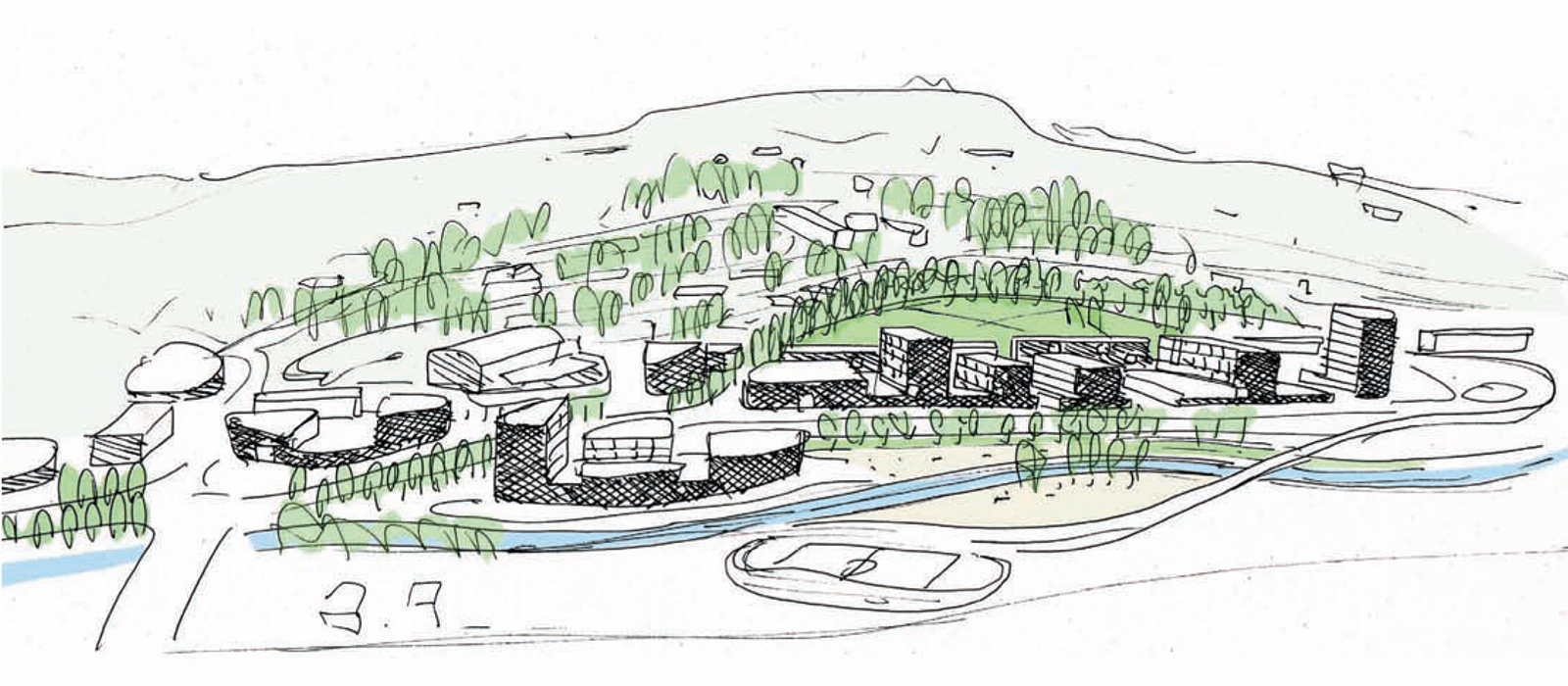Nuovo Quartiere Cornaredo
The area north of the urban center, spanning approximately one million square meters, is effectively the new gateway to the city.

In the northern outskirts of Lugano, the third gateway to the city was inaugurated in July 2012 with the opening of the Vedeggio-Cassarate Tunnel, nearly 3 km long, connecting the urban center to the highway. This development benefits not only mobility but also the urban planning of the area and the revitalization of Lugano's peripheral zones.
A new access route to Lugano
With the Vedeggio-Cassarate Tunnel, the route along the Cassarate river has become an effective alternative to other connections to the highway or, more generally, to the south and north of Lugano's urban center (Lugano Sud interchange and access via Pambio and Paradiso, respectively, Lugano Nord interchange and access via Besso or Massagno). The road network reorganization aimed to redistribute traffic among the three main routes, designating the Cassarate route as the primary penetration axis, intended to absorb at least 50% of the traffic from the Vedeggio-Cassarate Tunnel. This has opened new prospects for the development of Cornaredo, one of the northern districts on the outskirts of Lugano.
The redevelopment of the northern area of the city
The Nuovo Quartiere Cornaredo (New Cornaredo District), which covers approximately 1 million square meters, must address significant functional needs related to the new road connection and be seamlessly integrated into the individual and public slow mobility system. This is an essential premise for a sustainable development of the northern gateway to the city, for example, with regard to intermodal facilities and parking spaces for commuters.
The entire area will be transformed with recreational spaces and public and private infrastructure. It will be able to offer suitable venues for events of cantonal, national, and international interest, such as sports events, concerts, and other high-profile gatherings. This will meet a need not only for the City of Lugano but also for the entire Canton of Ticino.
The international competition
To identify innovative solutions that could economically and attractively integrate formal expectations with functional constraints and address the challenge of the Nuovo Quartiere Cornaredo, the City of Lugano, together with Porza, Canobbio, and the Dipartimento cantonale del territorio (Cantonal Department of Territory), launched an international urban planning competition in 2003.
In October 2004, an international jury selected, from among 14 projects, the work of an interdisciplinary group led by Professor Federico Oliva, who was tasked with developing the Masterplan (2006) for the Nuovo Quartiere Cornaredo. In June 2010, the intermunicipal zoning plan was approved, and its implementation was delegated to the Agenzia NQC, operational since 2012 and composed of representatives from Lugano, Porza, and Canobbio.

The intermunicipal Land Use Plan (PR-NQC).
A unified planning project for the Nuovo Quartiere Cornaredo was adopted and approved by the Canton of Ticino in 2010, aiming for a high standard of urban quality. An initial adjustment through amendments to the Land Use Plan, carried out in two distinct phases, was reviewed by the Dipartimento cantonale del territorio in 2016 and approved by the Consiglio di Stato (Council of State) in November 2019 (first phase) and February 2022 (second phase).
Specifically, the objectives of the first phase of the Land Use Plan amendments included:
- alignment with higher-level planning documents
- development of the regional and local road system
- a series of adjustments to enable the optimal integration of the new Polo sportivo e degli eventi PSE (Sports and Events Center)
- simplification of planning documents
The second phase aimed to update the allocation of residential quotas within the individual districts.
Progress of public works
The Agenzia NQC is coordinating the formal procedures to realize the public projects that make up the Cornaredo mosaic.
In spring 2021, the Lugano City Parliament approved the public-private partnership (PPP) agreement to build the Polo sportivo e degli eventi. In mid-January 2023, the City announced the start of preliminary works for the Arena Sportiva (Sports Arena) construction site. Phase 1 of the construction site began in July.
The redevelopment of the Cassarate river, with a new River Square, has received the building permit from the City Councils of Lugano and Canobbio. The CHF 3.8 million construction credit was approved by the Lugano City Parliament in November 2023.
For the final arrangement of the Pratone di Trevano, a large non-residential area dedicated to leisure and recreation, the procedure for relocating the shooting range to Monte Ceneri (scheduled for 2025) is proceeding on schedule, so the finalized project (already prepared) can begin construction by that date.
For the Parco di Trevano, the Agenzia NQC has initiated the design work for the woodland area in preparation for the final arrangement of this "green lung" of the urban agglomeration, with a necessary management concept for the forestry heritage across the entire Cornaredo area.
A definitive solution has been found for the Masseria di Cornaredo, whose conservation restoration was completed in autumn 2023. It now hosts the social canteen of the Fondazione Francesco. The project, also supported by the Rotary Club Lugano Lago, enabled the architectural and structural recovery of the complex and the introduction of new features. Among these are a meeting center for ACLI (Associazioni Cristiane Lavoratori Italiani), a multipurpose space with an attached shop/wine cellar, a restaurant open to the public, and a Bed & Breakfast accommodation.
The design work for the B1a sector, where the future nodo intermodale del trasporto pubblico (intermodal public transport hub) with the Park+Ride parking facility serving the entire Cornaredo area will be located, has also been initiated by private promoters.
The English version of this page was created with the aid of automatic translation tools and may contain errors and omissions.
The original version is the page in Italian.


